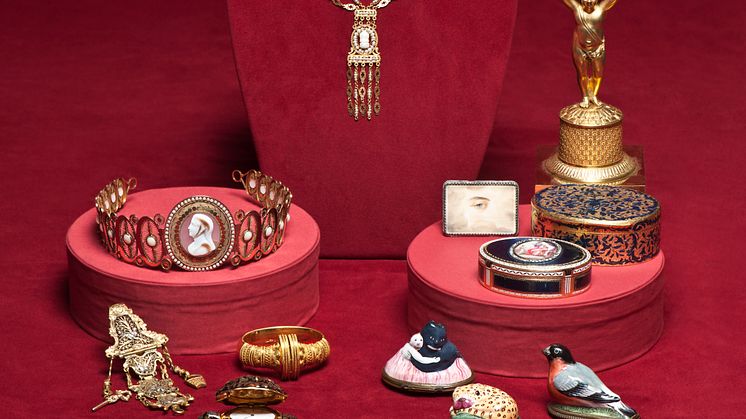
Press release -
The Jeweller’s Art – summer exhibition at Läckö Castle
Continuing its programming on the theme of art jewellery, Nationalmuseum is presenting an exhibition titled The Jeweller’s Art at Läckö Castle this summer. On show will be some 300 pieces – tiaras, necklaces, brooches, snuff boxes, pocket watches and miniature portraits – dating from 1650 to the present day. The materials range from gold, pearls and diamonds to plastic, eggshell and perch skin.
This summer’s exhibition at Läckö Castle, The Jeweller’s Art – Precious Objects from the 17th Century to the Present Day, features tiaras, necklaces, brooches, snuff boxes, pocket watches and beautifully mounted miniature portraits from Nationalmuseum’s collections. The 300 exhibits, dating from 1650 to the present, all exemplify great craftsmanship and reflect the artistic ideals of the day. Most of the pieces are being shown outside the museum for the first time, and many have never previously been exhibited at all.
The artifacts span a range of categories. Besides pure jewellery pieces, they include boxes, pocket watches and other accessories that illustrate the jeweller’s craft and creativity. Many of the older pieces, signifying wealth and power, were integral to the wearer’s identity and status. The contemporary pieces include some where the designer set out to push the boundaries of what constitutes a piece of jewellery. Gold, pearls and diamonds are often still present, alongside new materials like plastic, titanium, eggshell and perch skin.
Nationalmuseum possesses one of Sweden’s premier public collection of modern and contemporary jewellery, and the world’s largest collection of miniature portraits. The exhibition at Läckö Castle is part of an initiative to try out new ideas and collect feedback before creating a new treasury when the renovated museum reopens in 2018. More contemporary art jewellery can be seen in Open Space – Mind Maps, an exhibition running until 15 May 2016 at Nationalmuseum Design, located inside Kulturhuset Stadsteatern in Stockholm.
The Jeweller’s Art – Precious Objects from the 17th Century to the Present Day is on show at Läckö Castle from 11 June to 28 August 2016.
Press contact
Hanna Tottmar, Press Officer: hanna.tottmar@nationalmuseum.se, +46 767 234632
Caption
A selection of pieces from the exhibition The Jeweller’s Art – Precious Objects from the 17th Century to the Present Day.Photo: Bodil Beckman
Categories
Nationalmuseum is Sweden’s premier museum of art and design. The collections comprise older paintings, sculpture, drawings and graphic art, and applied art and design up to the present day. The museum building is currently under renovation and scheduled to open again in 2018. In the meantime, the museum will continue its activities through collaborations both in Sweden and abroad as well as temporary exhibitions at the Royal Swedish Academy of Fine Arts, Fredsgatan 12 and Nationalmuseum Design at Kulturhuset Stadsteatern in Stockholm. Nationalmuseum has partnerships with Svenska Dagbladet and the Grand Hôtel Stockholm, and acknowledges the support of FCB Fältman & Malmén.

